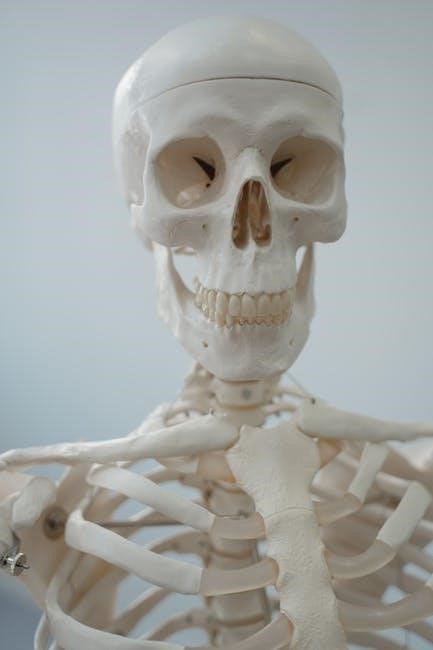Anatomy and physiology are the scientific studies of the human body’s structure and function. This discipline explores how body systems interact to maintain life and health, providing foundational knowledge for healthcare fields. The study guide outlines key concepts, branches like histology and cytology, and practical applications, serving as an essential resource for students.
1.1 Definitions and Scope
Anatomy is the scientific study of the structure and organization of living organisms, focusing on the physical form and arrangement of body parts. Physiology examines the functions and processes that enable life, such as movement, digestion, and respiration. Together, they provide a comprehensive understanding of how the human body operates, integrating knowledge from biology, chemistry, and neuroscience to address health and disease.
1.2 Branches of Anatomy and Physiology
Anatomy and physiology encompass various branches, including gross anatomy (study of visible structures), microscopic anatomy (tissues and cells), and histology (tissue study). Physiology branches into areas like neurophysiology and cardiovascular physiology. These specialized fields allow for in-depth exploration of body systems, enhancing understanding of human health and disease mechanisms, as outlined in comprehensive study guides.
1.3 Importance of Studying Anatomy and Physiology
Studying anatomy and physiology is crucial for understanding how the human body functions and maintains health. It provides essential knowledge for healthcare professionals, enabling accurate diagnoses and treatments. This field also underpins advancements in medical research and technology, while equipping students with problem-solving skills applicable in diverse scientific careers, as emphasized in study guides and educational resources.
Structural Units of the Human Body
The human body is organized into a hierarchy of structural units, from atoms and molecules to cells, tissues, organs, and systems, maintaining homeostasis and enabling life.
2.1 Levels of Organization
The human body is organized into a hierarchy of structural levels, starting from cells, the basic units, progressing to tissues, organs, and systems. These levels work together to maintain homeostasis and overall bodily functions, ensuring proper coordination and interaction among diverse components to sustain life and health.
2.2 Cells and Tissues
Cells are the fundamental units of life, functioning as the building blocks of the human body. Tissues are groups of specialized cells that perform specific functions. The body contains four primary types of tissue: epithelial, connective, muscle, and nervous. Cells and tissues work together to form organs and systems, enabling the body to maintain its complex processes and overall health effectively.
2.3 Organs and Systems
Organs are complex structures composed of two or more types of tissues that perform specific functions. Systems, such as the circulatory or digestive, are groups of organs working together to maintain body functions. Understanding the hierarchy from cells to tissues, organs, and systems is crucial for comprehending human anatomy and physiology, as each level contributes to the body’s overall functionality and health.
Anatomical Terminology
Anatomical terminology provides standardized language to describe body structures, movements, and procedures. It includes directional terms, planes, and sections, enabling precise communication about the human body’s organization and functions.
3.1 Basic Anatomical Terms
Basic anatomical terms form the foundation of understanding human body structure. Terms like proximal, distal, medial, and lateral describe locations. Anterior and posterior refer to front and back, while superior and inferior denote above and below. These terms are essential for accurately describing body regions and movements, aiding in clear communication in healthcare and scientific contexts. They provide a universal language for anatomical descriptions, ensuring consistency and precision in study and practice.
3.2 Directional Terms
Directional terms are crucial for describing the spatial relationships within the human body. Terms like anterior (front) and posterior (back) indicate position relative to a reference point. Superior refers to upper parts, while inferior denotes lower regions. Medial (toward the midline) and lateral (away from the midline) provide further precision. These terms enable accurate anatomical descriptions, facilitating effective communication among healthcare professionals and students. Understanding directional terminology is vital for mapping body structures and movements with clarity and consistency, ensuring precise communication in clinical settings and educational environments alike. These terms form the cornerstone of anatomical language, aiding in the localization of organs and systems. Proper usage enhances diagnostic accuracy and procedural outcomes, making them indispensable in medical practice. By mastering directional terms, individuals can better articulate anatomical positions, improving both study and professional interactions. This foundation is essential for advanced studies in anatomy and physiology, ensuring a clear and universal understanding of human body structure and function.
3.3 Planes and Sections
Planes and sections are essential tools for understanding the three-dimensional structure of the human body. The sagittal plane divides the body into left and right portions, while the frontal plane separates front from back. The transverse plane slices the body horizontally. These planes help create sections like cross-sections, which are vital for imaging and dissection. Proper identification of these planes aids in accurate anatomical descriptions and clinical diagnoses, making them fundamental for healthcare professionals and students to master. These visual representations enhance comprehension of complex structures and their spatial relationships, proving invaluable in both study and practical medical applications.
Skeletal System
The skeletal system comprises bones and joints, providing structural support, protection, and facilitating movement. It includes the axial and appendicular skeleton, functioning in blood cell production and overall stability.
4.1 Bones and Joints
Bones provide structural support and protection, while joints enable movement. The skeletal system includes long, short, flat, and irregular bones. Joints are classified as fibrous, cartilaginous, or synovial, with ligaments and tendons facilitating movement. Bones also produce blood cells and store minerals, while joints allow flexibility and stability, essential for locomotion and maintaining posture.
4;2 Axial and Appendicular Skeleton
The axial skeleton includes the skull, vertebral column, and ribcage, providing protection for vital organs like the brain and heart. The appendicular skeleton comprises the upper and lower limbs and pelvic girdle, enabling movement and locomotion. Together, these systems support the body’s structure and facilitate functional interactions between bones and muscles, ensuring mobility and stability.
Muscular System
The muscular system consists of skeletal, smooth, and cardiac muscles, enabling movement, maintaining posture, and supporting bodily functions like digestion and circulation. It works with the nervous system to coordinate actions and responses, making it essential for overall body mobility and functionality.
5.1 Types of Muscles
The human body contains three main types of muscles: skeletal, smooth, and cardiac. Skeletal muscles are voluntary, attaching to bones for movement. Smooth muscles are involuntary, found in internal organs, aiding functions like digestion. Cardiac muscle is specialized for the heart, enabling rhythmic contractions. Each type has distinct structures and functions, crucial for mobility, organ operation, and circulatory processes.
5.2 Muscle Structure and Function
Muscles consist of fibers, tendons, and connective tissue. Their primary function is contraction, enabling movement, stabilization, and maintaining posture. Skeletal muscles operate via the sliding filament mechanism, while smooth muscles rely on actin-myosin interactions. Muscle function is regulated by the nervous system, with motor neurons initiating contractions. Efficient muscle structure ensures optimal movement and bodily functions, essential for overall physical activity and health.

Nervous System
The nervous system is the body’s communication network, controlling voluntary and involuntary functions. It includes the brain, spinal cord, and nerves, enabling sensory input, motor responses, and coordination.
6.1 Structure of the Nervous System
The nervous system consists of the central nervous system (CNS), including the brain and spinal cord, and the peripheral nervous system (PNS), comprising sensory and motor nerves. The CNS processes information, while the PNS transmits signals between the CNS and body. This structural division enables efficient communication and control of bodily functions, ensuring coordinated responses to stimuli.
6;2 Functions of the Nervous System
The nervous system performs critical functions, including controlling voluntary movements, regulating involuntary processes like digestion, and facilitating sensory perception. It enables communication between different body parts, manages reflexes, and supports cognitive processes such as memory, learning, and decision-making. These functions collectively ensure the body’s adaptive and responsive nature to internal and external environments, maintaining overall health and functionality.

Clinical Applications and Terminology
Clinical applications of anatomy and physiology involve diagnosing and treating disorders, using terms like “etiology” and “pathophysiology.” Understanding these concepts aids in identifying diseases and their anatomical origins, enhancing patient care and treatment strategies effectively.
7.1 Clinical Terms and Their Significance
Clinical terms are essential for understanding diseases and treatments. Terms like “etiology” refer to the cause of a condition, while “pathophysiology” explains disease mechanisms. These terms are critical for diagnosis and treatment planning, linking anatomy and physiology to real-world patient care, ensuring accurate communication among healthcare professionals and effective management of medical conditions.
7.2 Anatomical Basis of Common Disorders
Understanding the anatomical basis of common disorders involves linking structural abnormalities to physiological dysfunctions. For example, cardiovascular diseases often stem from issues in the heart or blood vessels, while respiratory disorders may originate in the lungs. This knowledge aids in diagnosing conditions like diabetes, neurological impairments, and musculoskeletal injuries, emphasizing the importance of anatomy in clinical practice and patient care strategies.

Study Resources and Tools
Essential resources include PDF guides like “Anatomy & Physiology: The Unity of Form and Function” and digital tools such as Anatomy and Physiology Revealed, offering interactive learning aids and detailed visuals to enhance understanding of complex concepts and systems.
8.1 Recommended Textbooks and PDF Guides
Key textbooks include “Anatomy & Physiology: The Unity of Form and Function” by Kenneth Saladin and Elaine Marieb’s “Anatomy & Physiology.” PDF guides like “Anatomy & Physiology Study Guide” offer comprehensive reviews, covering muscle structure, clinical terms, and exam preparation. Free PDFs and digital resources from platforms like Simple Studies provide accessible learning materials for students.
8.2 Digital Tools for Learning Anatomy and Physiology
Digital tools like Anatomy and Physiology Revealed (APR) and Kenhub offer interactive 3D models and detailed diagrams. Platforms such as Complete Anatomy provide virtual dissection simulations, while tools like Histology Guide enable students to explore microscopic structures. These resources complement traditional study materials, offering engaging and immersive learning experiences for visual and hands-on learners.

Exam Preparation Strategies
Review class materials, including textbook chapters, notes, and PowerPoints. Practice with multiple-choice questions and focus on understanding clinical terms and their anatomical basis for exam success.
9.1 Effective Study Techniques
Incorporate active learning by engaging with flashcards, concept maps, and practice exams. Utilize visual aids like diagrams and videos to reinforce complex topics. Regularly review notes and textbook chapters, focusing on understanding rather than memorization. Prioritize difficult subjects and allocate time for each topic systematically to ensure comprehensive preparation for anatomy and physiology exams.
9.2 Practice Questions and Flashcards
Practice questions and flashcards are essential tools for reinforcing anatomy and physiology concepts. They help identify knowledge gaps and improve retention. Use multiple-choice questions to test understanding and flashcards to memorize key terms. Regularly reviewing practice exams and flashcard decks enhances problem-solving skills and prepares students for the format and content of actual exams, ensuring better performance and confidence.
Time Management for Anatomy and Physiology Studies
Effective time management involves balancing study and class time, ensuring adequate preparation for exams. Allocate specific hours for each topic and create a realistic study schedule.
10.1 Balancing Study and Class Time
Balancing study and class time is crucial for success in anatomy and physiology. Allocate specific hours for attending lectures, reviewing notes, and practicing with study guides. Dedicate additional time for self-study and interactive tools like Anatomy and Physiology Revealed. Regular review of class materials and practice exams ensures comprehensive understanding and retention of complex concepts.
10.2 Creating a Study Schedule
Creating a study schedule helps organize and prioritize learning. Allocate specific times for reviewing notes, practicing questions, and using resources like anatomy and physiology PDF guides. Break study sessions into manageable parts, focusing on key topics. Consistency is key; follow the schedule to ensure steady progress and effective preparation for exams and assignments.
Common Mistakes to Avoid
Common mistakes include misunderstanding key concepts, misusing anatomical terminology, and neglecting to review all class materials. Avoid relying solely on PDF guides without practical application or further study.
11.1 Misunderstanding Key Concepts
Misunderstanding foundational concepts like anatomy vs. physiology can hinder learning. Students often confuse anatomical structures with their functions, leading to poor exam performance. It’s crucial to grasp these basics thoroughly before advancing, as they form the building blocks of comprehension in this field.
11;2 Improper Use of Anatomical Terminology
Using anatomical terms inaccurately can lead to confusion and errors in understanding. Students often misuse directional terms or fail to apply correct prefixes and suffixes. Proper terminology is essential for clear communication in medical fields, emphasizing the need for meticulous study and practice to avoid such mistakes.
Advanced Topics in Anatomy and Physiology
Advanced topics include histology, cytology, and surface anatomy, focusing on detailed tissue studies and real-world applications. These subjects deepen understanding of complex bodily structures and functions.
12.1 Histology and Cytology
Histology examines tissue structures under a microscope, while cytology focuses on individual cells. These studies reveal how tissues form organs and function within the body, aiding in disease diagnosis. The PDF guide provides detailed images and descriptions to help students identify and understand cellular and tissue structures, essential for advanced anatomy and physiology studies.
12.2 Surface Anatomy and Its Applications
Surface anatomy studies external body structures and their relationships to internal organs, aiding in medical procedures like palpation and imaging. It is crucial for diagnosing conditions and guiding treatments. The study guide uses detailed images and surface landmarks to help learners identify anatomical features, enhancing clinical understanding and practical application in healthcare settings.
Final Review and Assessment
The final review involves summarizing key concepts, self-assessment through practice exams, and evaluating exam readiness. Study guides provide comprehensive summaries, flashcards, and practice questions to ensure thorough preparation and confidence for the exam, covering all major topics discussed throughout the course. Effective use of these tools enhances retention and understanding of anatomy and physiology principles. The assessment phase helps identify areas needing further review, allowing students to refine their knowledge and skills, ensuring they are well-prepared for the final evaluation. This systematic approach supports long-term learning and successful outcomes in anatomy and physiology studies. By utilizing the provided resources, students can achieve a solid grasp of the subject matter and perform optimally in assessments. Regular review and self-testing are emphasized as critical strategies for mastering complex topics and maintaining a high level of comprehension. The final assessment serves as a culmination of all learned material, requiring integrated knowledge and application of concepts to real-world scenarios, ensuring practical competence in the field. This chapter underscores the importance of consistent study habits and effective use of study aids to excel in anatomy and physiology. Through structured review and assessment, students can confidently demonstrate their understanding and readiness for future challenges in healthcare and related fields. The study guide’s final section offers a detailed plan for last-minute revision, focusing on high-yield topics and common exam questions, maximizing efficiency and minimizing stress. By adhering to this structured approach, learners can ensure a comprehensive understanding and successful completion of their anatomy and physiology course. Effective time management and focused study are key during this phase, ensuring all critical areas are thoroughly reviewed and understood. The final review and assessment phase is designed to reinforce learning, clarify doubts, and build confidence, essential for achieving academic success and professional competence. Utilizing the study guide’s resources during this stage is vital for optimizing outcomes and ensuring readiness for the exam. This chapter provides clear guidance on how to approach the final stages of study, emphasizing the importance of active learning and self-assessment. By following the outlined strategies, students can effectively consolidate their knowledge and perform at their best during the assessment. The study guide serves as an invaluable tool during this critical phase, offering targeted support and resources to facilitate success. Through diligent review and assessment, learners can attain a deep understanding of anatomy and physiology, enabling them to apply their knowledge effectively in various healthcare scenarios. This final chapter highlights the significance of thorough preparation and the practical application of learned concepts, ensuring students are well-equipped for their future endeavors. The comprehensive review and assessment process outlined in this section is tailored to meet the diverse needs of learners, providing a clear pathway to achieving their academic and professional goals. By engaging with the study guide’s materials and adhering to the recommended strategies, students can confidently navigate the final stages of their anatomy and physiology studies and excel in their assessments. The final review and assessment phase is a critical juncture, requiring focused effort and strategic use of available resources to ensure success. This chapter provides the necessary tools and guidance to help learners achieve their full potential, reinforcing the importance of consistent study and effective preparation. The study guide’s final section is dedicated to helping students transition from learning to application, ensuring they are fully prepared to demonstrate their knowledge and skills in real-world contexts. Through structured review and targeted assessment, learners can build a robust foundation in anatomy and physiology, essential for advancing in their chosen fields. The final review and assessment process is designed to be both comprehensive and practical, offering students the opportunity to refine their understanding and apply their knowledge effectively. By utilizing the study guide’s resources and following the recommended strategies, students can approach their exams with confidence and achieve their desired outcomes. This chapter emphasizes the importance of thorough preparation and self-assessment, providing learners with the tools and techniques needed to succeed in their anatomy and physiology studies. The final review and assessment phase is a vital component of the learning process, enabling students to consolidate their knowledge and demonstrate their mastery of the subject matter. Through active engagement with the study guide’s materials and consistent practice, learners can ensure they are well-prepared for their exams and future challenges in the field. The study guide’s final section offers a detailed and structured approach to review and assessment, helping students to identify areas for improvement and reinforce their understanding of key concepts. By following the outlined strategies, learners can achieve a high level of proficiency in anatomy and physiology, essential for their academic and professional success. This chapter provides a clear roadmap for the final stages of study, emphasizing the importance of organized review and focused practice. Through the effective use of the study guide’s resources, students can optimize their learning outcomes and perform at their best during the assessment. The final review and assessment phase is a critical period that requires careful planning and execution, ensuring that all aspects of the course material are thoroughly understood and can be applied in practical situations. By adhering to the study guide’s recommendations and engaging in regular review and self-testing, learners can build a strong foundation in anatomy and physiology, enabling them to excel in their studies and future careers. This chapter highlights the significance of a structured approach to learning, providing students with the necessary tools and strategies to achieve their goals. The final review and assessment process is designed to be both challenging and rewarding, pushing learners to reach their full potential and ensuring they are well-prepared for the demands of the field. By utilizing the study guide’s comprehensive resources and maintaining a commitment to consistent study, students can successfully navigate the final stages of their anatomy and physiology course and achieve their desired outcomes. This chapter serves as a culmination of the study guide, offering learners a clear path to success through targeted review and assessment. By following the outlined strategies and actively engaging with the provided materials, students can ensure they are fully prepared to excel in their exams and apply their knowledge effectively in real-world contexts. The final review and assessment phase is an opportunity for learners to demonstrate their understanding and mastery of anatomy and physiology, and the study guide provides the necessary support to help them achieve this goal. Through dedicated effort and strategic use of available resources, students can confidently approach their exams and look forward to successful outcomes in their academic and professional pursuits.
13.2 Self-Assessment and Exam Readiness
13.1 Summarizing Key Concepts
Summarizing key concepts involves condensing major topics into concise points, ensuring understanding and retention. Study guides provide summaries, flashcards, and practice questions to aid revision. This step helps identify weak areas, allowing focused study. It reinforces foundational knowledge, such as anatomical terminology and body systems, ensuring a solid grasp of anatomy and physiology principles before the final exam.
